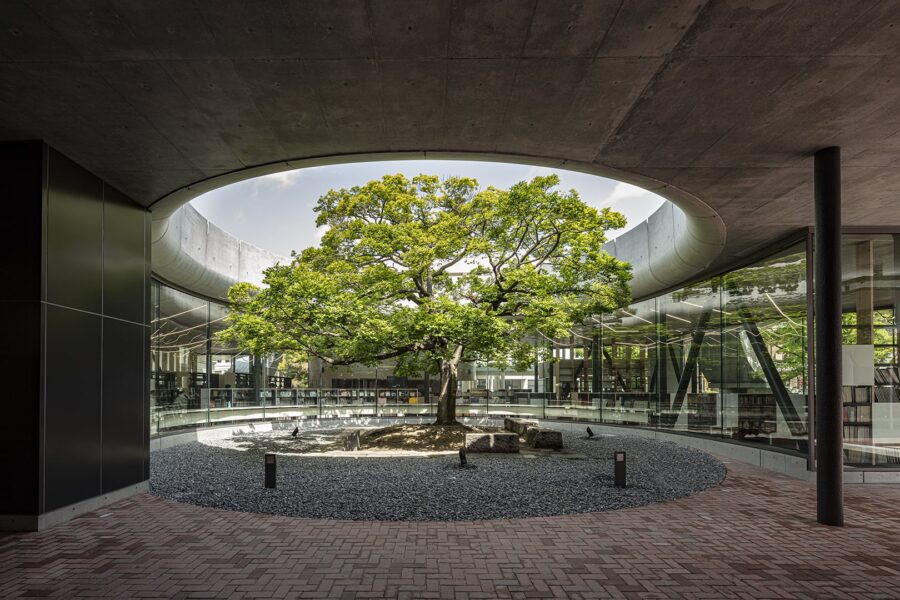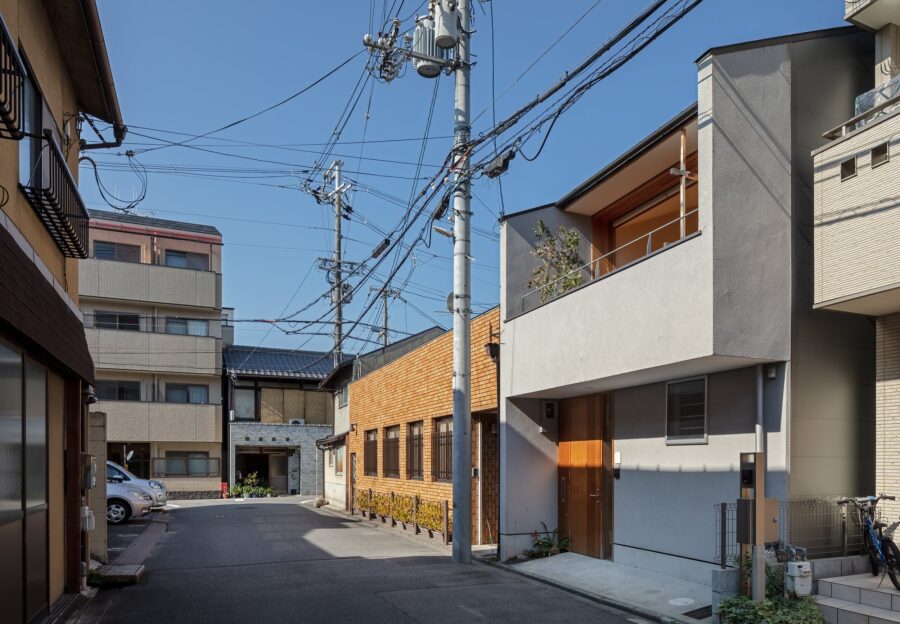都市郊外の川沿いに建つ2世帯住宅である。クライアントは音楽家で、地域の音楽教育にも関わっているため、小さな音楽ホールとしても使えることが求められた。また、地域の基幹産業であるセメント関連の仕事に従事しているため、建物をコンクリートでつくることになった。
敷地の東側を流れる川の向こうには田園風景が広がり、西側には筑豊の山々が見える。川沿いの道路からの視線をコントロールするために、敷地を少し高くして道路沿いに塀を設け、南北に長い敷地中央に建物を建てて庭を両側に確保した。
1階は南北の庭に対して開放し、芸術作品のギャラリーになる広い玄関、音楽ホールになる居間、そして主に子世帯が使う食堂、厨房、寝室などを配置している。特徴的な曲面を描く高い天井の頂部には天窓があり、曲面は光を柔らかく拡散させ、音楽の演奏時には音を拡散させる役割を果たす。
一方、親世帯の住戸と個室中心の2階は東西方向に開放し、できるだけ自然豊かな眺望が得られるようにしている。ほんの数世代前の日本では住宅を冠婚葬祭などの場として使うことで、コミュニティがつくられていたように、空間がクライアントの生活を豊かに彩るだけでなく、コンサート会場やギャラリーなどとしても活用され、より豊かな地域社会を築いてゆく拠点になればと思う。(末廣香織、末廣宣子)
A musician's residence with a curved ceiling that colors light and sound
A two-generation residence sits in the suburb of a small city. The client, a musician, involved with local music education, requested us a home with a small music hall function. Since the client works in the cement business, a major regional industry, we decided to use concrete as the primary construction material. The rectangular lot is aligned north to south, with a river running along the southeast side.
The east view towards the river and rice fields beyond it is completely open, while Chikuhou Mountains are visible to the west. The character of the interior spaces differs on each floor.
The first floor, which opens onto gardens that run from north to south, includes a large entryway that also serves as a gallery of artworks and a living room as the music hall, as well as a dining room, kitchen, and bedroom used primarily by the younger generation. The distinctive curved ceiling distributes the soft light from the skylights into the space.
In contrast, the second floor, where the older generation lives, opens east and west, overlooking the river and the rich natural scenery. Compared to the first floor, the scale is smaller and more enclosed. The tube-shaped rooms were designed as places to relax while sitting on the floor. Architecture has the potential to become a cultural and social asset. Even residences can go beyond their role as the space for individual lives. Just a few generations ago, houses in Japan were used as sites for ceremonial gatherings that helped to create communities. In this project, the space not only enriches the client’s life but, through its function as a concert hall and gallery, becomes a center point for enriching the entire community. (Kaoru Suehiro, Noriko Suehiro)
【行橋の住宅】
所在地:福岡県行橋市
用途:戸建住宅
クライアント:個人
竣工:2012年
設計:NKS2アーキテクツ
担当:末廣香織、末廣宣子、馬淵健太(元所員)
構造設計:桃李舎
設備・電気設計:シード設計社
照明設計:LIGHT PLAN
電気施工:アイテック
外構・造園:水野文化園
家具:木季工房
施工:緒方組
撮影:Kouji Okamoto
工事種別:新築
構造:RC造
規模:地上3階
敷地面積:1125.67m²
建築面積:319.76m²
延床面積:412.37m²
設計期間:2010.12-2011.07
施工期間:2011.09-2012.06
【JUUL house】
Location: Yukuhashi-shi, Fukuoka, Japan
Principal use: Residential
Client: Individual
Completion: 2012
Architects: NKS2 Architects
Design team: Kaoru Suehiro, Noriko Suehiro, Kenta Mabuchi / former staff
Structure engineer: Tourisha
Equipment, electrical design: Seed Sekkeisha
Lighting design: LIGHT PLAN
Electrical construction: ITEC
Exterior, Landscape: Mizuno Bunkaen
Furniture: Kiki Koubou
Contractor: Ogatagumi
Photographs: Kouji Okamoto
Construction type: New Building
Main structure: Reinforced Concrete construction
Building scale: 3 stories
Site area: 1125.67m²
Building area: 319.76m²
Total floor area: 412.37m²
Design term: 2010.12-2011.07
Construction term: 2011.09-2012.06








